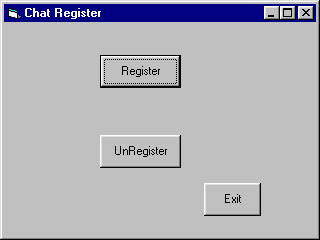Written by: Harris Phram
Participates: Patty Buchanan and Tom Curry
VIII. Registering COM Objects in Visual BasicRegistering COM Objects in Visual Basic 5.0 or 6.0
In order to have the DirectX7 program work under the launcher, it must be registered in the registry. The following program based upon the DirectX Documentation is an example of how to register and unregister these programs using the functions in the DirectX 7 for Visual Basic Type Library.
Step 1
Create a VB project and add the resource for the DirectX 7 for Visual Basic Type Library as instructed in the section on How to Compile A DirectX Application with Visual Basic 5.0 or 6.0.
Step 2
Create a form with three command buttons on it. One to register the program, one to unregister the program and one to exit the program.

Step 3
Below is a listing of VB code using the DirectX 7 library.
General Declarations
Dim dx As New DirectX7
Dim dpl As DirectPlayLobby3
Const AppGuid = "{EB5E7E20-0303-11d3-9AAB-00104BCC1EAA}"
Private Sub cmdExit_Click()
Unload Me
End
End Sub
Private Sub cmdRegister_Click()
Call RegisterApp
End Sub
Private Sub RegisterApp()
Dim dpappdesc As DPAPPLICATIONDESC2
Dim dpl As DirectPlayLobby3
With dpappdesc
.strApplicationName = "DXVBCHAT"
.strCommandLine = ""
.strCurrentDirectory = App.Path
.strDescription = "Chat (DirectX for Visual Basic)"
.strFilename = "DXVBChat.exe"
.strGuid = AppGuid
.strPath = App.Path
End With
On Local Error GoTo ERRORS
Set dpl = dx.DirectPlayLobbyCreate
Call dpl.RegisterApplication(dpappdesc)
Exit Sub
ERRORS:
MsgBox "Failed to register application."
Unload Me
End Sub
Private Sub cmdUnRegister_Click()
Call UnregisterApp
End Sub
Private Sub UnregisterApp()
On Local Error GoTo FAILED
Call dpl.UnregisterApplication(AppGuid)
MsgBox "Unregistration successful."
Exit Sub
FAILED:
If Err.Number = DPERR_UNKNOWNAPPLICATION Then
MsgBox "Application not registered."
End If
Unload Me
End Sub